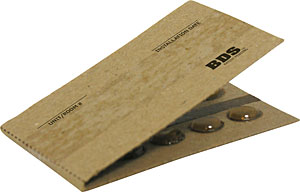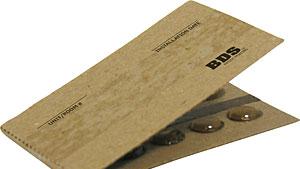Establishing a bedbug monitoring program: Monitoring device options for successful intervention
Editor’s note: The following is the third of a three-part series on bedbugs and how to defend facilities against them. Ed Dolshun, Northwest U.S. and Canada regional sales manager for Brooklyn, N.Y.-based Atlantic Paste and Glue, Professional Pest Control Products Division, wrote the series.
Considering the widespread nature of today’s bedbug infestations, it is not surprising that a variety of monitoring options are being used.
One of the newest methods involves the distribution of matchbook-sized insect monitors that specifically target bedbugs. The monitors, when strategically placed, offer a tool to detect the presence of bedbugs by using an adhesive drop matrix that helps capture individual bugs. The product is priced specifically to accommodate large-scale monitoring programs. Here’s a video that describes the Catchmaster BDS monitor, and a video from the Fairfax County, Va., health department that says what to do for a bedbug infestation.

Once the monitors are in place, regular checks can help pinpoint an infestation before it spins out of control. The frequency of the process is site-specific, depending on varying conditions at any given location. Timing is also important because bedbugs tend to forage nightly and, once they have fed, it takes up to 14 days before they are likely to forage again. That means that a minimum time period of two weeks would be appropriate before re-checking the monitors.
Another approach features an active monitor designed much like a briefcase. The device uses a battery and CO2 cartridge along with a chemical attractant.
Yet another device uses chemical products to attract bugs and draw them to a pitfall trap. This is in the form of a “ramp” on one side that is rough enough for bedbugs to crawl over but includes a smooth surfaced, sharp drop-off on the other side that forces the critters to slide into a container.
Government building managers could typically place from six to 12 monitors per room, where they are most likely to encounter bedbugs.
Summary
Needless to say, not every device is as effective as the user would like. As of yet, we have not been able to develop a “silver bullet” for bedbug detection and control. It is important to choose a system whose design is based on known science of bedbug traits and physiology. The real determining factor should be based on laboratory as well as field data that shows what the bedbugs are and what they want.
Bedbug monitoring is a challenge that works best only when it is combined with the experience and knowledge of a trained professional. Pest management professionals can provide assistance and help ensure that the right level of protection is put in place.
Regardless of the approach, awareness and taking action are the key requirements. Considering the growth of the bedbug problem, complacency is a certain sign of trouble ahead.

Ed Dolshun is the Northwest U.S. and Canada regional sales manager for Brooklyn, N.Y.-based Atlantic Paste and Glue, Professional Pest Control Products Division. He spent 17 years as an environmental specialist for the Bergen County, N.J., Division of Community Development, where he also served as administrator for a federally funded lead-based paint abatement program.
Check Government Product News throughout the year for descriptions of pest-fighting products. The Facilities and Parks & Recreation one-stops on Govpro.com have information on pest control products.




















